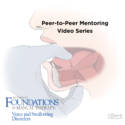Tongue-based manual therapy and sensory receptive preferences Gentle, patient-informed manual therapy through the oral region has become a mainstay of the work I teach and use. With usages ranging from articulation and feeding difficulties to dysphagia concerns, there is good reason to explore gentle, sustained tongue engagements to improve awareness and sensory motor control. In… Continue Reading





